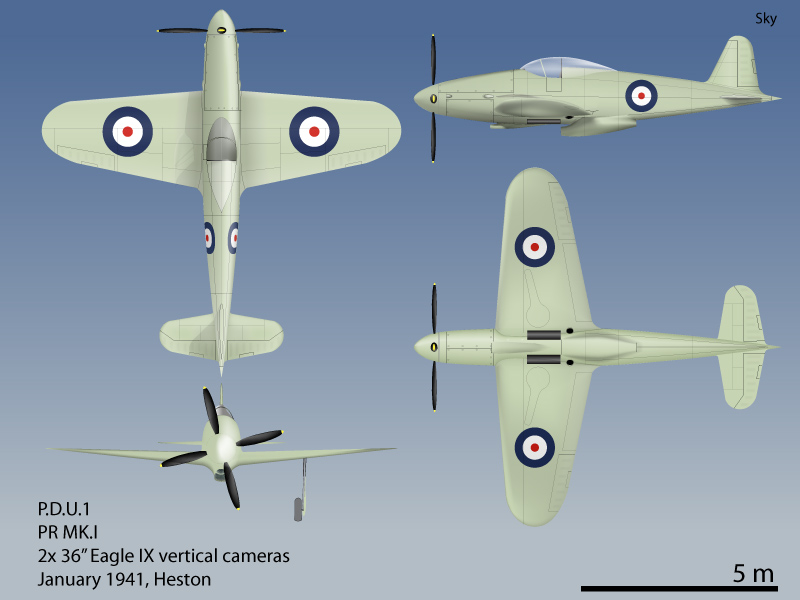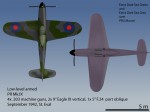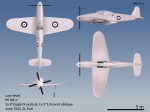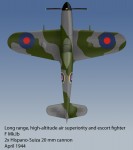P.D.U.1
2
Comments
What if...?
Illustrations are copyright Ben Micklem 2009, based on original plans from the 1940 proposal.
In the tense months leading up to the Battle of Britain in the Summer of 1940, the Air Ministry was re-shuffled and personnel reduced from 7,000 to 4,000. The RAF Commands were reorganised, and aircraft production re-examined. Lord Beaverbrook, Minister for Aircraft Production, gave Rolls-Royce instructions to prioritise development superchargers, and to focus on just two engine lines- the Merlin and the Griffon. The 1940 proposal from Joe Smith, Chief Designer at Supermarine, to fit the Griffon into the Spitfire was rejected- there were other plans for the engine.
Illustrations are copyright Ben Micklem 2009, based on original plans from the 1940 proposal.
In the tense months leading up to the Battle of Britain in the Summer of 1940, the Air Ministry was re-shuffled and personnel reduced from 7,000 to 4,000. The RAF Commands were reorganised, and aircraft production re-examined. Lord Beaverbrook, Minister for Aircraft Production, gave Rolls-Royce instructions to prioritise development superchargers, and to focus on just two engine lines- the Merlin and the Griffon. The 1940 proposal from Joe Smith, Chief Designer at Supermarine, to fit the Griffon into the Spitfire was rejected- there were other plans for the engine.
Off the drawing board
Heston Aircraft were requested to produce three prototypes of the P.D.U.1, one of which was to have lengthened wings. The longer wings were to allow four 20mm cannon to be fitted, and also improve climb rate. The first prototype flew on December 9th, 1940, and production was approved after its performance proved satisfactory.High Speed Reconnaissance
In its intended photographic role, the PDU.1 was unsurpassed. When two stage, three speed superchargers were introduced in 1943, the Griffon's potential of 2,500 bhp was achieved. Carrying out photographic runs at 40,000 ft, in a pressurised cockpit with excellent visibility, it proved almost impossible to intercept. It soon made the Spitfire obsolete for all PR tasks- including the low-level dicing raids. In this operations, its speed and fast roll rate (due to the very short wings) more than made up for its lower climb rate when evading anti-aircraft fire and enemy aircraft.Success as a fighter
In by late 1941 the first fighter variants entered service, in time to defend against the 'tip and run' attacks of the Fw 190. These were of the F Mk.IIb (long wing, 4x 20mm cannon) type- the cannon armament being preferred by this point in the war. The high speed, endurance and unrivalled visibility (even the glass floor had been retained) of the P.D.U.1 led to success of the short winged F Mk.Ib (2x 20mm cannon) as a high altitude escort fighter in the last year of the war. It was the still the fastest allied type available to counter the Luftwaffe jet and rocket aircraft.Comments
A great read, very well thought out and structured.
Ok scratchbuilders, lets see one !!
OCT 25, 2009 - 08:37 PM
Copyright ©2021 by Ben Micklem. Images also by copyright holder unless otherwise noted. The views and opinions expressed herein are solely the views and opinions of the authors and/or contributors to this Web site and do not necessarily represent the views and/or opinions of AeroScale, KitMaker Network, or Silver Star Enterrpises. Images also by copyright holder unless otherwise noted. Opinions expressed are those of the author(s) and not necessarily those of AeroScale. All rights reserved. Originally published on: 2009-10-22 00:00:00. Unique Reads: 9488














